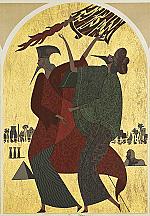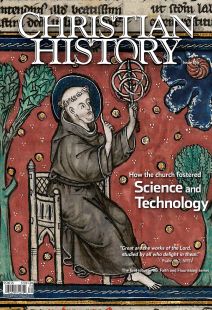Science and Technology: Recommended resources
Books
Several books on the relationship between Christianity and science throughout church history include David Lindberg and Ronald Numbers, eds., God and Nature (1986); John Hedley Brooke, Science and Religion (2014) and, with Geoffrey Cantor, Reconstructing Nature (2001); and the Dictionary of Christianity and Science (2017) edited by Paul Copan, Tremper Longman III, Christopher Reese, and Michael Strauss.
Read more about the flourishing of science in the Middle Ages in Edward Grant, God and Reason in the Middle Ages (2001); Peter Harrison, The Fall of Man and the Foundations of Science (2007); James Hannam, The Genesis of Science (2011); and David Lindberg, The Beginnings of Western Science (2010).
Studies of Hildegard of Bingen abound; you can start with Fiona Bowie and Oliver Davies, ed., Hildegard of Bingen: An Anthology (1995); Priscilla Throop, trans., Hildegard von Bingen’s Physica (1998); Mark Atherton, Selected Writings: Hildegard of Bingen (2001); Bruce Hozeski, trans., Hildegard’s Healing Plants (2002); Carmen Acevedo Butcher, Hildegard of Bingen (2009); and Beverly Mayne Kienzle, Debra Stoudt, and George Ferzoco, eds., A Companion to Hildegard of Bingen (2013).
To learn about Albert the Great, read Irven Resnick, ed., A Companion to Albert the Great (2013). For more on Robert Grosseteste, consult Robert Grosseteste on the Six Days of Creation (1996); F. A. C. Mantello and Joseph Goering, translators, The Letters of Robert Grosseteste, Bishop of Lincoln (2010); and Jack Cunningham and Mark Hocknull, eds., Robert Grosseteste and the Pursuit of Religious and Scientific Learning in the Middle Ages (2016). For Roger Bacon, check out Jeremiah Hackett, ed., Roger Bacon and the Sciences (1997); and Amanda Power, Roger Bacon and the Defence of Christendom (2013).
To understand the Scientific Revolution, look at Charles Hummel, The Galileo Connection (1986); J. L. Heilbron, The Sun in the Church (1999); Kenneth J. Howell, God’s Two Books (2004); Floris Cohen, How Modern Science Came into the World (2012). To understand Kepler in more detail, check out James R. Voelkel, Johannes Kepler and the New Astronomy (2001); and James A. Connor, Kepler’s Witch (2004). A good book on Boyle is Michael Hunter, Boyle: Between God and Science (2009). You can also look at David Livingstone, D. G. Hart, and Mark Noll, eds., Evangelicals and Science in Historical Perspective (1999) for more on science and belief in European and American church history.
To learn more about Michael Faraday, consult Geoffrey Cantor, Michael Faraday: Sandemanian and Scientist (1991); and Frank A. J. L. James, Michael Faraday: A Very Short Introduction (2010). For James Clerk Maxwell, look at Ivan Tolstoy, James Clerk Maxwell, A Biography (1981); and Matthew Stanley, Huxley’s Church and Maxwell’s Demon (2016).
George Washington Carver has attracted many biographers: some good places to start are Linda McMurry Edwards, George Washington Carver, Scientist and Symbol (1989); John Perry, Unshakable Faith (1999), which also profiles Booker T. Washington; Mark Hersey, My Work Is That of Conservation (2011); and the second edition of George Washington Carver: In His Own Words, ed. Gary Kremer (2017).
Christian History issues
Read these related issues of Christian History on our website. Some are still available for purchase.
73: Thomas Aquinas
76: The Christian Face of the Scientific Revolution
107: Debating Darwin
Videos from Vision Video
Videos on the theme of this issue include Has Science Killed Christianity?; Philosophy, Science, and the God Debate; More Than My Brain; Reasonable Doubt; Stumbling Blocks to Faith; The Call of the Cosmos; the Faith and Science Lecture Forum series; and Towards Belief.
Websites
Most of the thinkers discussed in this issue can be found in the Stanford Encyclopedia of Philosophy, which will give you good brief introductions to their lives and thoughts. The History of Science department at Oklahoma University has a wealth of resources (including many images we’ve used in this issue!). BioLogos has several series of articles on the history of religion and science in America; you can also read about Hitchcock in particular at DinoTracks Discovery.
The Counterbalance Foundation, which we recommended in issue #76, is still around (as is its companion website for the PBS documentary Faith and Reason) and has articles on a number of topics linking science and faith. James Hannam maintains a website on science and faith at Bede’s Library.
As always, primary source works of many notable people we’ve profiled are available at the Christian Classics Ethereal Library, Project Gutenberg, and the Medieval Sourcebook and Modern History Sourcebook. CH
By the editors
[Christian History originally published this article in Christian History Issue #134 in 2020]
Next articles
Plagues and epidemics: Did you know?
Where quarantine came from, how epidemics almost killed Bede and Finney, those beaky masks, and why it’s not “Spanish” flu
Paul E. Michelson and othersEditor's note: Plagues and epidemics
Every year this plague issue would get kicked down the road as other issue concepts rose in priority.
Bill CurtisThe plagues that destroyed
A survey of epidemics and some Christian responses
Darrel W. Amundsen and Gary B. FerngrenSupport us
Christian History Institute (CHI) is a non-profit Pennsylvania corporation founded in 1982. Your donations support the continuation of this ministry
Donate





